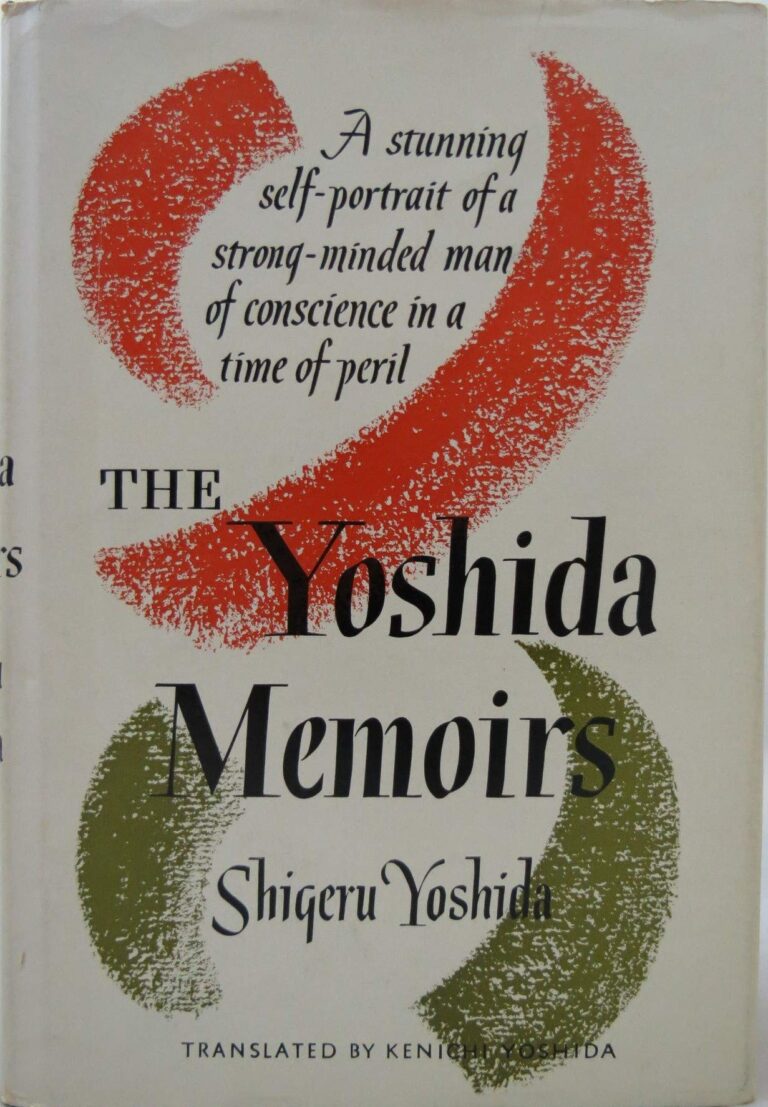Shigeru Yoshida, The Yoshida Memoirs: The Story of Japan in Crisis (1962)
Shigeru Yoshida was the leader of the Japanese Liberal Party and Prime Minister of Japan from 1946-7 and 1948-54. He played a pivotal role in reorientating Japan to take a pro-West position in the context of the Cold War, a position which has largely endured since. Indeed, the ‘Yoshida Doctrine’ of close alliance with the United States is often said to have defined Japan’s security strategy ever since World War Two.
Born in Tokyo in 1878, Yoshida studied law at Tokyo Imperial University before entering the foreign ministry. He had a storied diplomatic career, being posted to China, Italy, Sweden, Norway and Denmark before being appointed Ambassador to Great Britain in 1936. Although supportive of Japanese military involvement in China, Yoshida’s extensive time in the West made him oppose any military conflict with Britain or the United States, preferring to promote trade ties over pursuing hardline economic nationalism. In April 1945 he was arrested for supporting a move to seek an early peace settlement, one which would have prevented the dropping of the atomic bomb.
With this track record, Yoshida was well placed to succeed in occupied Japan during the post-war period. He joined the new Liberal Party formed in 1945 (near simultaneous with the creation of Menzies’s Australian version), and won a House of Representatives seat at the general election which was held with remarkable rapidity in April 1946. The Liberals won that election, against Progressive, Socialist, Communist and Cooperative Parties, eventually forming a coalition with the Progressives. However, their leader Ichirō Hatoyama was soon disbarred by the Americans for his involvement in pre-war Cabinets, and Yoshida was persuaded to take his place.
Yoshida thus became Prime Minister during the crucial early Cold War period in which the San Francisco Peace Treaty was negotiated. This ‘soft peace’ was notable for its comparative lack of reprisals against Japan, and was promoted by the Americans who wanted Japan to rebuild and become a crucial strategic ally – but this remained a matter of extreme controversy in Australia.
Already, during the war Menzies had argued that the Allies must not repeat the mistakes of Versailles and instead offer Japan a peace that would allow her citizens a decent standard of living, however he would face a delicate task in convincing the Australian public to acquiesce to the American plan. He visited Australian troops in Japan in 1950, but Yoshida was conveniently away in the countryside, avoiding what would have been seen as a premature reconciliation between the leaders of the two countries (the first ‘official’ visit of an Australian PM to Japan would not take place for another seven years).
Nevertheless, the Tokyo administration was already seeking to offer olive branches to Australia. That same year, they hosted a number of Australian journalists for a tour of Japan, telling them to report back that the Japanese government was ‘ashamed’ of the atrocities that had been committed during the war, wanted to forge friendly relations with Australia, and was keeping a close and supportive eye on Menzies’s attempt to ban the communist party. In 1952, after the Menzies Government had signed the San Francisco Treaty partly as a precondition to securing ANZUS, Yoshida even sent a public Australia Day message urging closer ‘political, commercial and cultural relations’ between the two countries. That same year the Yoshida Government would appoint Haruhiko Nishi as the first Japanese Ambassador to Australia since the war. In 1954 Australia would formally sponsor Japan’s admission to the Colombo Plan – an important symbolic gesture that signaled that Australia had fully signed on to the American strategy of trying to keep Japan in the Western bloc. It was a slow thaw, but Yoshida’s efforts eventually paid off, helping to lay the groundwork for the landmark 1957 Australia-Japan Commerce Agreement.
Out of office in 1959, Yoshida would take a private trip to Australia, during which he had talks with senior members of the Menzies Cabinet. When he published his memoirs in 1962, he felt compelled to personally send a copy to Robert Menzies. The book only mentions Australia on a few occasions, but it makes it clear that apart from the Soviet Union (which obviously loathed Japan for siding with the Americans), Australia was the country most opposed to any form of Japanese rearmament.
You might also like...
Sign up to our newsletter
Sign up for our monthly newsletter to hear the latest news and receive information about upcoming events.



